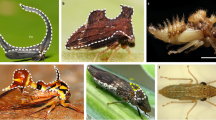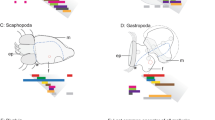Abstract
CRUSTACEANS and insects share a common origin of segmentation1,2, but the specialization of trunk segments appears to have arisen independently in insects and various crustacean subgroups3,4. Such macroevolutionary changes in body architecture may be investigated by comparative studies of conserved genetic markers5á¤-7. The Hox genes are well suited for this purpose, as they determine positional identity along the body axis in a wide range of animals8á¤-10. Here we examine the expression of four Hox genes in the branchiopod crustacean Artemia frandscana, and compare this with Hox expression patterns from insects. In Artemia the three ᤘtrunkᤙ genes Antp, Ubx and abdA are expressed in largely overlapping domains in the uniform thoracic region, whereas in insects they specify distinct segment types within the thorax and abdomen. Our comparisons suggest a multistep process for the diversification of these Hox gene functions, involving early differences in tissue specificity and the later acquisition of a role in defining segmental differences within the trunk. We propose that the branchiopod thorax may be homologous to the entire pregenital (thoracic and abdominal) region of the insect trunk.
This is a preview of subscription content, access via your institution
Access options
Subscribe to this journal
Receive 51 print issues and online access
$199.00 per year
only $3.90 per issue
Buy this article
- Purchase on Springer Link
- Instant access to full article PDF
Prices may be subject to local taxes which are calculated during checkout
Similar content being viewed by others
References
Dohle, W. & Scholtz, G. Development 104 (suppl.), 147–160 (1988).
Patel, N. H., Kornberg, T. B. & Goodman, C. S. Development 107, 201–212 (1989).
Calman, W. T. Crustacea (Black, London, 1909).
Walossek, D. Fossils and Strata 32, 1–202 (1993).
Averof, M. & Akam, M. Curr. Biol. 3, 73–78 (1993).
Slack, J. M. W., Holland, P. W. H. & Graham, C. F. Nature 361, 490–492 (1993).
Arendt, D. & Nubler-Jung, K. Nature 371, 26 (1994).
Lewis, E. B. Nature 276, 567–570 (1978).
Akam, M., Dawson, I. & Tear, G. Development 104 (suppl.), 123–133 (1988).
McGinnis, W. & Krumlauf, R. Cell 68, 283–302 (1992).
Akam, M. et al. Development 120 (suppl.), 209–215 (1994).
Andersen, D. T. Aust. J. Zool. 15, 47–91 (1967).
Manzanares, M., Marco, R. & Garesse, R. Development 118, 1209–1219 (1993).
Kelsh, R., Weinzierl, R. O. J., White, R. A. H. & Akam, M. Devl Genet. 15, 19–31 (1994).
Warren, R. W., Nagy, L., Selegue, J., Bates, J. & Carroll, S. Nature 372, 458–461 (1994).
Snodgrass, R. E. Comparative Studies on the Head or Mandibulate Arthropods (Comstock, New York, 1951).
Mahaffey, J. W., Diederich, R. J. & Kaufman, T. C. Development 105, 167–174 (1989).
Beeman, R. W., Stuart, J. J., Brown, S. J. & Denell, R. E. BioEssays 15, 439–444 (1993).
Ueno, K., Hui, C.-C. Fukuta, M. & Suzuki, Y. Development 114, 555–563 (1992).
Karch, F., Bender, W. & Weiffenbach, B. Genes Dev. 4, 1573–1588 (1990).
Tear, G., Akam, M. & Martinez-Arias, A. Development 110, 915–925 (1990).
Li, X. & Noll, M. Nature 367, 83–87 (1994).
Rothe, M., Pehl, M., Taubert, H. & Jackle, H. Nature 359, 156–159 (1992).
Castelli-Gair, J., Greig, S., Micklem, G. & Akam, M. Development 120, 1983–1995 (1994).
Vachon, G. et al. Cell 71, 437–450 (1992).
Jurgens, G. & Hartenstein, V. in The Development of Drosophila melanogaster (eds Bate, M. & Martinez-Arias, A.) 687–746 (Cold Spring Harbor Laboratory Press, 1993).
Scourfield, D. J. Phil. Trans. R. Soc. B214, 153–187 (1926).
Riek, E. F. Rec. S. Aust. Mus. 27, 313–321 (1968).
McNamara, K. J. & Trewin, N. H. Palaeontology 36, 319–335 (1993).
Dohle, W. Myriapoda and the Ancestry of Insects (Manchester Polytechnic, Manchester, 1988).
Author information
Authors and Affiliations
Rights and permissions
About this article
Cite this article
Averof, M., Akam, M. Hox genes and the diversification of insect and crustacean body plans. Nature 376, 420–423 (1995). https://doi.org/10.1038/376420a0
Received:
Accepted:
Issue Date:
DOI: https://doi.org/10.1038/376420a0
This article is cited by
-
The identification, adaptive evolutionary analyses and mRNA expression levels of homeobox (hox) genes in the Chinese mitten crab Eriocheir sinensis
BMC Genomics (2023)
-
Expression of posterior Hox genes and opisthosomal appendage development in a mygalomorph spider
Development Genes and Evolution (2023)
-
Characterizing Hox genes in mayflies (Ephemeroptera), with Hexagenia limbata as a new mayfly model
EvoDevo (2022)
-
The mimetic wing pattern of Papilio polytes butterflies is regulated by a doublesex-orchestrated gene network
Communications Biology (2019)
-
Patterns of Gene Expression Variation across Body Parts of the Hydrothermal Vent Shrimp Nautilocaris saintlaurentae
Ocean Science Journal (2019)
Comments
By submitting a comment you agree to abide by our Terms and Community Guidelines. If you find something abusive or that does not comply with our terms or guidelines please flag it as inappropriate.



